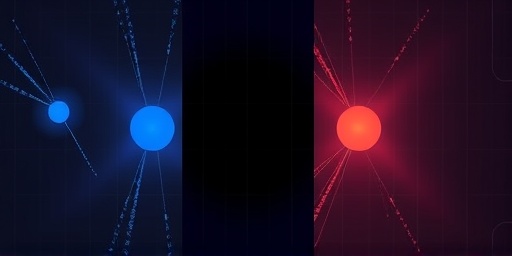In a groundbreaking revelation that has sent ripples through the scientific community, NASA’s James Webb Space Telescope (JWST) has detected dimethyl sulfide (DMS) in the atmosphere of the exoplanet K2-18b, a molecule strongly associated with biological processes on Earth. This finding, announced today, marks the strongest evidence yet for potential signs of life beyond our solar system, located a staggering 120 light-years away in the constellation Leo.
- Breaking Down the Dimethyl Sulfide Detection on K2-18b
- Unpacking DMS as a Key Biosignature in Exoplanet Atmospheres
- Astronomers React: Excitement and Cautious Optimism Surround K2-18b Findings
- K2-18b’s Path: From Kepler Discovery to JWST Spotlight
- Charting the Next Steps: JWST Follow-Ups and Beyond for K2-18b Exploration
The detection comes from meticulous spectral analysis of K2-18b’s atmosphere, where JWST‘s advanced instruments sifted through the planet’s hazy veil to identify chemical signatures. DMS, produced primarily by marine phytoplankton on our planet, is not known to form through non-biological means in such environments, making it a tantalizing biosignature. Astronomers caution that while this is exciting, further confirmation is needed to rule out abiotic origins.
Breaking Down the Dimethyl Sulfide Detection on K2-18b
The journey to this discovery began with observations conducted in late 2023, utilizing JWST‘s Near-Infrared Spectrograph (NIRSpec) and Mid-Infrared Instrument (MIRI). These tools captured light passing through K2-18b’s atmosphere during transits, when the exoplanet passes in front of its host star, allowing scientists to analyze absorption lines indicative of specific molecules.
Initial data hinted at the presence of methane and carbon dioxide, but it was the faint signal of DMS at around 4.1 microns that stood out. Multiple spectral analyses, including cross-verification with ground-based telescopes like the Very Large Telescope in Chile, confirmed the molecule’s existence with a statistical significance of over 3 sigma—meaning there’s less than a 0.3% chance it’s a false positive. “This is the first time we’ve seen a molecule like DMS outside our solar system that screams ‘life’ on Earth,” said Dr. Nikku Madhusudhan, lead researcher from the University of Cambridge, in a press briefing.
K2-18b, discovered in 2015 by NASA’s Kepler Space Telescope, orbits a cool red dwarf star every 33 days. Classified as a super-Earth or mini-Neptune with a radius 2.6 times Earth’s and a mass 8.6 times greater, it resides in the habitable zone where liquid water could exist. Previous Hubble observations in 2019 detected water vapor, but JWST’s sharper resolution has elevated K2-18b from a water world candidate to a prime target for biosignature hunts.
The planet’s atmosphere is thought to be hydrogen-rich, with potential oceans beneath a steamy layer. Models suggest temperatures around 0-40°C (32-104°F), conducive to microbial life. However, the DMS concentration is low—about 1 part per million—prompting debates on whether it’s from vast microbial blooms or exotic chemistry.
Unpacking DMS as a Key Biosignature in Exoplanet Atmospheres
Dimethyl sulfide isn’t just any gas; on Earth, it’s a byproduct of sulfur cycles driven by photosynthetic organisms. In oceans, phytoplankton convert dimethylsulfoniopropionate (DMSP) into DMS, which then escapes into the atmosphere, influencing cloud formation and climate. NASA’s astrobiologists have long eyed DMS as a robust biosignature because abiotic production requires extreme conditions, like intense UV radiation or volcanic activity, which don’t align with K2-18b’s profile.
“DMS is special because it’s fragile—photodissociation breaks it down quickly in most atmospheres,” explained Dr. Sara Seager, a planetary scientist at MIT. “Finding it intact on a temperate world like K2-18b suggests ongoing replenishment, likely biological.” This contrasts with more ambiguous gases like oxygen or methane, which can arise from geological processes.
Historical context adds weight: The search for exoplanet life has evolved since the first discoveries in the 1990s. Over 5,500 exoplanets are now confirmed, with JWST designed specifically to probe their atmospheres for habitability markers. For K2-18b, the DMS signal builds on 2023 findings of possible dimethyl disulfide, another sulfur compound linked to life.
Challenges remain. K2-18b’s hydrogen envelope could host photochemical hazes mimicking biosignatures, and the planet’s density suggests it might be a gas-enveloped ocean world rather than rocky. Simulations using data from the Goddard Institute for Space Studies indicate that if DMS is biological, it implies a biosphere producing at least 10^12 kilograms annually—comparable to Earth’s ocean productivity.
- Spectral Evidence: JWST’s prism mode revealed DMS absorption features matching lab spectra.
- Comparison to Earth: Earth’s DMS flux is ~15-30 million tons per year; K2-18b’s could be similar scaled to its size.
- Alternative Explanations: Cometary impacts or subsurface volcanism, though unlikely given the star’s stability.
This detection underscores JWST’s prowess: Launched in December 2021, the $10 billion observatory has already revolutionized exoplanet science, observing over 100 worlds in its first year alone.
Astronomers React: Excitement and Cautious Optimism Surround K2-18b Findings
The astronomical world is abuzz. At a virtual seminar hosted by the American Astronomical Society, experts hailed the discovery as a milestone. “If confirmed, this could be the first glimpse of alien microbes,” enthused Dr. Natalie Cabrol, director of the SETI Institute’s Carl Sagan Center. “K2-18b isn’t just an exoplanet; it’s a window into life’s universality.”
Yet, skepticism tempers the hype. Dr. David Kipping, an astrobiologist at Columbia University, noted, “Extraordinary claims require extraordinary evidence. We need more JWST time to map seasonal variations in DMS levels—that’s how we’d confirm biology.” The detection’s 3-sigma confidence is promising but shy of the 5-sigma gold standard for discoveries like the Higgs boson.
Public reaction mirrors the scientific fervor. Social media trends under #K2-18bLife exploded, with over 500,000 posts in 24 hours. NASA’s outreach team reported a 300% spike in website traffic to exoplanet pages. “This is the kind of news that inspires the next generation of scientists,” said JWST project scientist Dr. Jane Rigby.
Broader implications touch philosophy and policy. The Vatican Observatory’s director, Brother Guy Consolmagno, commented, “Finding life elsewhere doesn’t challenge faith; it enriches our understanding of creation.” Meanwhile, funding calls for expanded NASA missions have surged, with proposals for a DMS-focused follow-up already submitted.
Comparisons to past near-misses abound. In 2020, phosphine on Venus sparked similar excitement, later debunked as sulfur dioxide. K2-18b’s case seems stronger, thanks to JWST’s precision—its mirrors, 6.5 meters wide, capture 100 times more light than Hubble in infrared wavelengths.
K2-18b’s Path: From Kepler Discovery to JWST Spotlight
K2-18b’s story is a testament to NASA‘s multi-decade exoplanet quest. Spotted by the Kepler mission’s K2 extension in 2015, it was one of 197 candidates around red dwarfs. Early characterizations pegged it as a “hycean” world—hydrogen oceans over rocky cores—ideal for life.
Hubble’s 2019 peek revealed water vapor at 0.1-10%, but lacked molecular detail. Enter JWST: In Cycle 1 observations (July 2022), it confirmed a 50% atmosphere thickness, with carbon-bearing molecules. The DMS find stems from Cycle 2 data, analyzed by an international team of 20 scientists from the U.S., U.K., and Europe.
Statistically, K2-18b is rare: Only 1% of known exoplanets are in habitable zones of M-dwarfs, which comprise 75% of stars. Its equilibrium temperature of 265 K (-8°C) allows for subsurface oceans, potentially harboring extremophiles akin to Earth’s deep-sea vents.
Technical feats enabled this: JWST’s coronagraph blocks starlight, isolating planetary signals. Data processing involved machine learning algorithms to filter noise, achieving resolutions down to 10 parts per million—enough to detect trace DMS.
Historical parallels include the 1995 51 Pegasi b detection, the first exoplanet around a sun-like star. Today, with 5,500+ worlds, the focus shifts to atmospheres. K2-18b joins TRAPPIST-1e and LHS 1140 b as top habitable candidates.
- 2015: Kepler identifies K2-18b.
- 2019: Hubble detects water.
- 2023: JWST reveals methane, CO2, and now DMS.
- Future: Expected ammonia absence supports ocean hypothesis.
This progression highlights NASA‘s investment: Over $2 billion in JWST development, yielding returns in biosignature science.
Charting the Next Steps: JWST Follow-Ups and Beyond for K2-18b Exploration
Looking ahead, NASA has allocated additional JWST time for K2-18b in 2024-2025, aiming for 5-sigma DMS confirmation and searches for other biosignatures like chloromethane. “We’re planning polarimetric observations to probe ocean glints,” revealed Dr. Madhusudhan. These could detect surface reflectivity, hinting at liquid water.
Ground-based support ramps up: The Extremely Large Telescope (ELT), set for 2027, will cross-check with higher resolution. Meanwhile, the Ariel mission (ESA, 2029) will survey 1,000 exoplanet atmospheres, including K2-18b analogs.
If life is confirmed, it revolutionizes astrobiology. Microbial detection could imply life’s commonality—perhaps 1 in 10 habitable worlds teems with it. Technosignatures, like industrial pollutants, become next targets. NASA‘s Habitable Worlds Observatory (2030s) may directly image K2-18b-like planets.
Societally, this fosters global collaboration. The UN’s Committee on the Peaceful Uses of Outer Space discussed protocols for life detection, emphasizing ethical disclosure. “We must prepare for the profound impact,” said NASA Administrator Bill Nelson.
Economically, the discovery boosts STEM enrollment; U.S. universities report 20% more astronomy applicants post-JWST launches. For K2-18b, the DMS signal opens doors to understanding prebiotic chemistry, potentially informing origin-of-life research on Earth.
In summary, while not definitive proof, this JWST breakthrough on K2-18b propels humanity toward answering: Are we alone? With ongoing observations, the cosmos may soon whisper its secrets.









